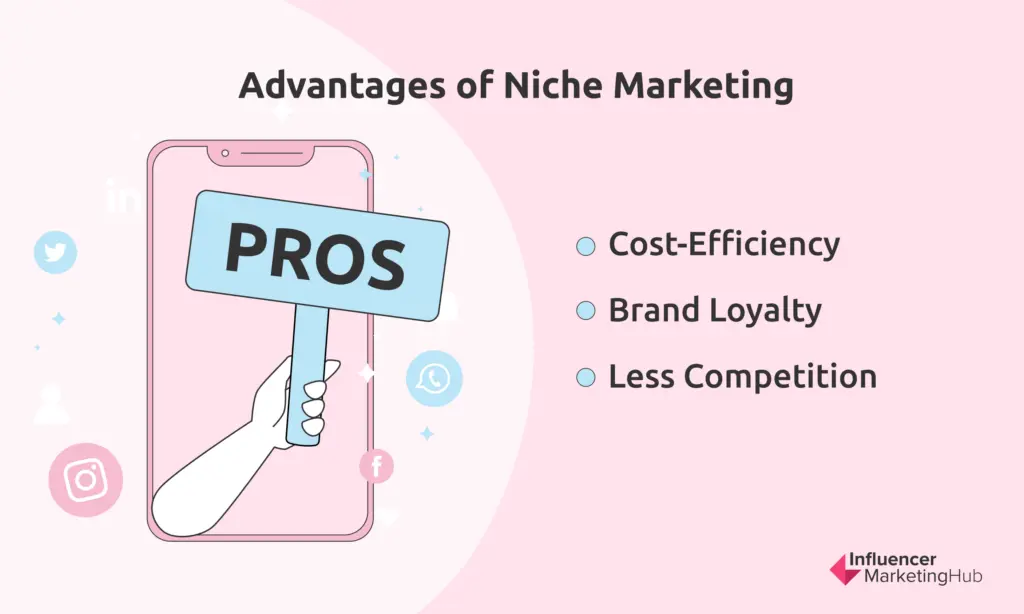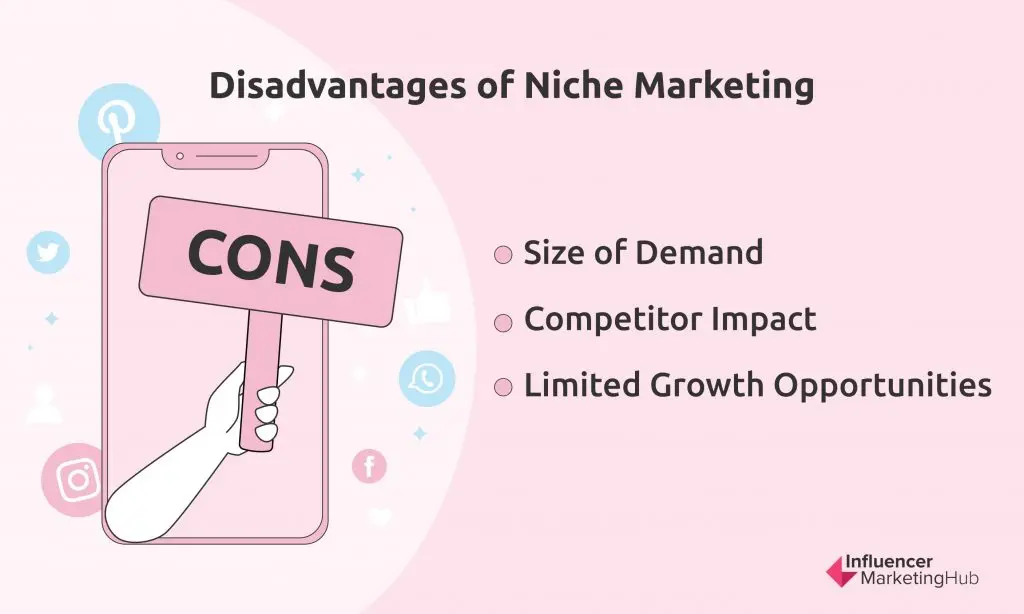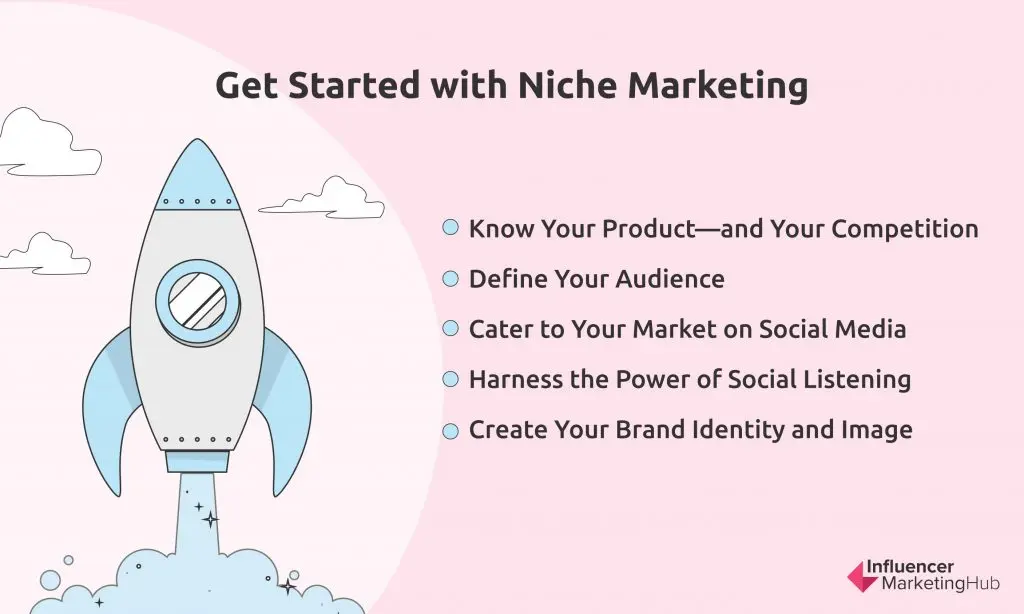Niche marketing is a strategy that involves targeting a specific group of people instead of the general population. Rather than spending hundreds or thousands of dollars in a scattered marketing campaign, niche marketing allows companies to be more focused and direct in their approach.
Niche markets are smaller segments of a broad customer population. They can be defined in any number of ways, and may be highly specialized or a bit more general. For instance, you can define a niche market within the fashion industry, such as the segment of fashion-forward customers who are into minimalist or monochromatic styles or work fashion consumers who value comfort above all else.
Niche marketing is not yelling, “Hello, everyone! I have a great new product for you!” out in a crowded street, but saying, “Hey, fashionistas! We’ve got the latest in hot goth jackets for you today!” One is vague and doesn’t address anyone in particular; the other is much more targeted and has a specific product.
How to Do Niche Marketing:
Advantages and Disadvantages of Niche Marketing
There are many benefits of niche marketing:

- Cost-Efficiency
When you have a specific group of people in mind, your marketing messages are more targeted and direct, and more appealing. Niche marketing, then, is considered more cost-effective.
It tends to have a higher conversion rate than marketing to broader populations, since ads and marketing campaigns focus on specific problems and solutions that are more attractive to potential customers. You won’t have to spend money convincing people that they need your product. Most niche market consumers already know what they need and are just looking for a solution.
- Brand Loyalty
Businesses can form more meaningful relationships with their customers instead of trying to reach out to everyone at once. When customers are engaged with the brand, it can lead to high quality relationships and loyalty. Loyalty makes ambassadors out of customers; these are the people who will promote and recommend your business to their peers for free, and is one of the biggest advantages of brand loyalty for companies.
- Less Competition
When you are offering a niche product to a targeted audience, there are fewer competitors offering the same thing. This advantage comes with a caveat, though. Marketers must know how to identify lucrative market segments in which there are fewer competitors.
However, do not fall into the trap of marketing to a niche audience simply just because there is no competition. There are also certain factors to be wary of:

- Size of Demand
When establishing a niche, evaluate whether it’s just a market that’s underserved or if it’s really just barely existent. There might be little to no competition because there is no demand, and therefore, no sales.
Think of a doctor specializing in a highly specific area—say, an orthopedic surgeon focusing on hand surgery. You may find more general orthopedic surgeons than hand surgeons, so a skilled hand surgeon may find himself without direct competitors. On the other hand, he may have no competitors because there is no real need for a hand surgeon in the area where he is.
- Competitor Impact
Less competition means that once a competitor does manage to enter the market, its impact to you will be more significant. Because you’re fighting over a small slice of the pie, you will feel the effect of a competitor much more, especially if your niche market is already small.
- Limited Growth Opportunities
Since your market is already very specific, the only ways for growth to happen is if the market itself expands or if you are able to identify a new niche market for the same product.
Get Started with Niche Marketing

1. Know Your Product—and Your Competition
One of the most important things in marketing is mastering your product. This is especially true for niche marketing, since your product caters to a highly focused target segment. It is not enough to merely be familiar with your product or service. You have to understand it fully in order to identify the people who need and will most likely use it.
You also have to study your closest competitors—their product, their branding and marketing campaigns, their market share and performance. The more you know about these things, the better it’ll help you with your own strategy, whether it’s adopting their best practices or shying away from tactics that prove unproductive.
2. Define Your Audience
Once you know your product or service, it’s time to identify and define your market segment. Marketers use what is called “buyer persona” to describe their target customer. A buyer persona details a prospective or target customer’s profile, such as their age, gender, profession, interests or hobbies, needs, and other information. It is based not on speculative data, but rather on research.

Aside from surface-level details like age, gender, and profession, a buyer persona also describes a typical day in the life of the customer, as well as challenges they face daily. This allows marketing teams to identify pain points that their product can address and use in their marketing campaigns.
Defining an audience is arguably the most important step in niche marketing. Without a clearly specified audience, a niche marketing strategy is more likely to fail. Your audience will determine your messaging and delivery tactics, so without a customer profile or buyer persona, you will basically be going in blind without a definite plan of action, wasting marketing dollars.
Do note that a “well-defined audience” does not necessarily mean a small market segment. The size of your target segment need not comprise only ten people. “Well-defined” simply means a specific group of people, such as people of a certain profession, hobbyists, a particular gender, or an age group.
3. Cater to Your Market on Social Media
Social media is now more dynamic than ever. Being active on social media can help you reach more potential customers in your niche. With the abundance of digital marketing techniques for social media today, you can easily hyper-target your audience and be discoverable by people who would find your niche relevant. Social media can easily connect you to your niche market, no matter where they are.
In marketing to niche audiences, the language and aesthetic you use are also important. You want to attract the attention of a group of people with a specific interest or need, so you need to know what topics to talk about and what creative tone to use. Doing so will help you establish your brand identity and expertise in your niche area, allowing you to gain your customers’ trust and loyalty.
4. Harness the Power of Social Listening
Because of the speed of technology nowadays, consumers are prone to shifting interests and needs. It is therefore important to be always attuned to what your market segment is saying. The buyer persona gives you a somewhat in-depth look at a picture of your customers, but consumers do evolve.
When you listen to conversations—for instance, in social media—about your product, you can get real data on the things you need to improve or other problems you can address.
Some of the ways in which you can practice social listening is by creating a public community on messaging apps, such as WhatsApp or Telegram, that is centered on your product. This is a great way for niche markets to develop good relationships with brands and encourage brand loyalty.

In addition, these communities can give businesses a better sense of what their target market wants and needs. They can receive direct feedback about their product, or they can draw valuable insight and conclusions from the conversations that can pinpoint significant gaps that need addressing.
You can also use tools for social listening to help you increase your brand image and reputation online.
5. Create Your Brand Identity and Image
Your brand identity and image should align with the needs and concerns of your niche market. This is why buyer personas are so important: they will set the direction of your entire branding strategy, from your unique value proposition to your marketing campaigns.
In niche marketing, your audience is already well defined by default; it should follow that your branding is as well defined. A good branding strategy for a niche market should:
- Be aligned with your company’s values and the values of your market
- Clearly show your unique value proposition
- Resonate with and appeal to your niche market
- Have a price point that aligns with your chosen market
These elements of good branding can only be achieved if you do the first four steps right.
How to Find A Niche Market
It may be tough to find a niche market that is both lucrative and untouched, but it doesn’t mean that it is impossible. Work your way down from the broader market and decide on the subset of the market that your products and services can cater to.
You can take a look at your close competitors to find out what segment of the population they market to. You can use that as a starting point for building your own niche market.
You can also use Google searches, using significant keywords to find out what people are looking for within a particular category. For instance, searching for “healthy snacks for kids” may give you an idea of the popular items that are selling, and it can also lead you to information about who are buying and recommending these items. It can even provide you with additional keywords to try out, such as “organic chips,” or “sugar-free candies.”
Google’s autofill function can help you identify some underserved markets. When you type in a search query, you’ll see the most searched for keywords. Don’t ignore these. Check out what other people are searching for, and you’ll get a clue about products and services that people look for.

Strategies for Effective Niche Marketing
Niche marketing demands specialized strategies on social media. Sure, you can still use good old blogging and regular social media posts, but niche markets need more fine-tuning, precisely because they are a specific group of people whom you want to please.
Select the Most Appropriate Advertising Platform
The buyer persona you’ve crafted should give you information on where you’ll find your customers and how to attract their attention. For example, in the US, younger people under 30 tend to be on Snapchat, TikTok and Instagram, while older ones favor Facebook and YouTube. Therefore, if you are targeting Gen Z people, it would make more sense to be on TikTok than on Facebook.
Sometimes, even these big social media platforms won’t cut it if your market does not use them for the particular purpose you are targeting. The bottom line is, go where your market is, and advertise on those platforms to make sure that your marketing budget is spent wisely.
User-Generated Content
One of the most significant changes in the field of marketing is the increased power of the consumer. Celebrity endorsements are not the only factor that makes a person buy a product. Today, reviews from peers and other users have significant weight as well. The best people to harvest social media content from are your repeat customers—the loyal ones who buy your products again and again. Customers can post their own content to showcase your product and use hashtags for maximum exposure. In this world of social media, user-generated content platforms can offer more credibility than company-driven, professional advertising, especially for niche markets.
Collaboration
You can also take advantage of partnerships with influencers or other experts in your niche market as a strategy. Collaborating with experts can not only raise your brand’s credibility but also enable you to expand your audience.
Examples of Niche Marketing
There are a variety of niche markets that your business can serve. Among the more popular ones today are:
- Environmentally-conscious customers
- LGBTQ+ community
- Mothers and parents
- Health, wellness, and fitness buffs
- Pet owners
Of course, even within these market segments, you can still opt for a more specific group. You can either target vegans or customers who are concerned about plastic pollution and climate change. You can go for working mothers, stay-at-home moms, or single parents. The way you define your niche market is dependent upon the product or service you offer.
Here are some real-world examples of niche marketing done right:

Lefty’s is a store in San Francisco that caters to left-handed people. From kitchen tools to school supplies for lefty kids, Lefty’s has it all for that 10% of the population who struggle using tools for right-handed people. Some are novelty items and are meant as gag gifts or a joke, but they do carry useful items made for left-handed people.
The store uses SEO, keywords, and pay-per-click advertising as part of their niche marketing strategy online. A person looking for “left-handed scissors”, for example, might come across an ad for Lefty’s.
This is an excellent example of a niche market that is very simply defined, yet specific. The left-handed market segment is quite often underserved.

For the eco-conscious customer, Bee’s Wrap is one of the better choices for food storage. The company sells plastic-free wrappers for food, made from organic cotton, beeswax, tree resin, and plant oil—all sustainably sourced and ethically produced. The wrap is re-sealable, washable, reusable for up to a year, and can be composted. The company has also developed vegan wraps, substituting vegan-friendly candelilla wax for beeswax.
The market for vegan and eco-friendly products has only begun to be popular in recent years. A decade ago, companies like Bee’s Wrap might have a more difficult time reaching or even identifying their niche market. This is the importance of social listening for businesses—new opportunities and markets might just be around the corner if you keep your ear on the ground and listen well to what people are saying.
A food and beverage marketing agency can help you come up with similar marketing campaigns.

Our next example features two seemingly different yet not mutually exclusive market segments. The Natural Dog Company targets pet owners who are also environmentally conscious. It’s a niche market within another niche market. Their products are organic, fragrance-free, and made especially for fur babies.
Because of this niche market, the Natural Dog Company was able to distinguish itself from other pet product stores and establish a unique brand image for their customers. They went beyond the common niches for pet owners and ventured toward the conscious consumer niche. It’s a lesson for business owners to not be afraid to step further in defining their target audience.



